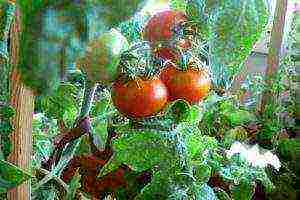Content
Read: 1 346
To grow zucchini on your own loggia, you do not need a lot of space or special equipment.
Home garden on the windowsill or loggias city apartments have long been a great alternative to weekly trips on the dacha, especially in modern conditions of a catastrophic lack of free time.
Given the limited space of window sills and balconies, it is necessary to carefully approach the choice of crops for growing. The most common vegetables for home cultivation are cucumbers, tomatoes, hot and sweet peppers, radishes, and carrots. Much less often in home beds can be found zucchini... Let's talk about how to grow zucchini on the windowsill.
Why zucchini?
Zucchini is a real storehouse of useful elements and minerals. They are rich in potassium, calcium, magnesium, zinc and copper, and also contain vitamins: A1, B1, B2, C, PP.
The unconditional use of zucchini is in its low calorie content. There are only 24 calories per 100 grams of this vegetable. It is this parameter that makes zucchini one of the favorite foods of nutritionists. This vegetable has practically no taste of its own, has a beneficial effect on digestion and maintains healthy skin.
The high potassium content helps to normalize the body's water balance and helps to get rid of excess fluid. A mild diuretic and choleretic effect allows you to remove toxic substances from the body.
What should be considered when growing zucchini at home?
Variety selection... The first thing to do is to decide on the variety. For growing zucchini at home best fit compact early maturing varieties. Also, when making a choice, it is necessary to take into account the time of the year and the side of the world, on which the loggia or window opens, on which the zucchini will be located. If the cultivation takes place in the autumn-winter period, and the windows face the north side, then preference should be given to varieties that are distinguished by the maximum indicators of resistance to temperature extremes and various stresses.
Plants placement... For zucchini need deep enough containers or boxes 15-25 centimeters high. At the bottom of the box, drainage must be laid out - 5 centimeters. A tray for excess liquid is placed under it.
In summer, for full-fledged growth, zucchini is quite enough sunlight, however, in winter and autumn, fluorescent lamps or special phyto-lamps for seedlings may be needed. Before planting zucchini or any other crops at home, you need to carefully consider the cost of this equipment. If the balcony faces strictly south, then you should think about protecting vegetables from direct sunlight. To avoid burns to leaves and fruits, zucchini are covered with gauze.
Soil selection... In vegetable gardens, squash in most cases grows on peat, compost, fertilized with manure. However, it is not recommended to take land from vegetable gardens for home cultivation. The best option for these purposes will be a special soil for seedlings.
Planting and caring for zucchini on the windowsill
So, the seeds of the required varieties have been purchased, and the boxes with the prepared soil have been prepared.All that remains is to plant the zucchini correctly and, with proper care, the crop will not make you wait longer than necessary.
To begin with, the seeds must be wrapped in damp gauze for a couple of days to form roots. If after two days the root has not hatched, then, most likely, such a seed will not sprout.
Pre-prepared soil must be well watered with water at room temperature.
Further, the sprouted seeds are planted in the ground to a depth of 3 centimeters with the root down. After a week, fertilizer should be applied for seedlings. As it grows, the ground around the sprouts needs to be loosened. Regular watering is also a must.
In order for the fruits to set, the zucchini needs pollination. In the open field, bees and wasps are excellent at this task. However, in the city, especially on high floors, problems with natural pollination can arise. In this case, zucchini must be artificially pollinated by rubbing the male flower of the plant against the female one. If, nevertheless, the windows are located no higher than the fifth floor, and the seedlings are on a balcony or loggia with open windows, then you can spray the zucchini with a solution of sugar or honey. The sweetness will attract bees and other pollinators.
To grow zucchini on your own loggia, you do not need a lot of space or special equipment. It is enough just to devote a little of your time and attention to the process.
Good luck!

Zucchini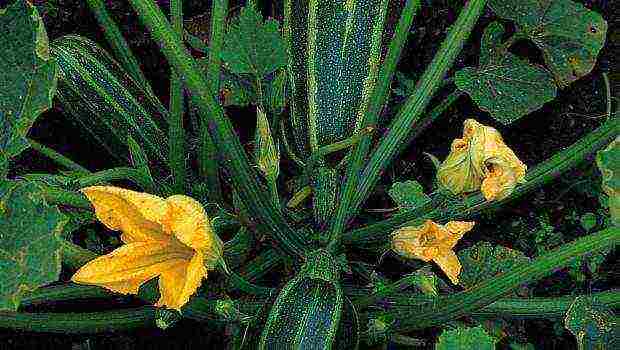
Published by 28.04.2014 |
Previously, zucchini was grown for industrial purposes, for feed to farm animals. Therefore, it was plucked already large, ripe enough or even overripe. And only in the twentieth century, which drew people's attention to a healthy lifestyle and proper nutrition, marrow as one of the dietary and healthy products appeared on the tables of ordinary people. Moreover, for food they began to collect vegetables that have not reached maturity, which have a soft and delicate structure and not developed seeds.
Of course, this amazingly tasty and healthy vegetable was eaten before. The zucchini was fried, stewed, canned. There are many recipes that contain this product, and caviar from this wonderful vegetable was one of the favorite and popular products of the Soviet Union!
History and legends about the pub
Zucchini is more than one thousand years old. It is believed that his homeland is Central America, or rather Mexico, from where he came to Europe, and then spread throughout the world. According to another legend, India is considered the birthplace of this vegetable: the zucchini was presented to women waiting for their husbands from a long voyage and praying for their safe return, the gods.
Today, zucchini is ubiquitous. It is loved for its delicate taste, it goes well with other vegetables in different dishes, and has a lot of useful properties.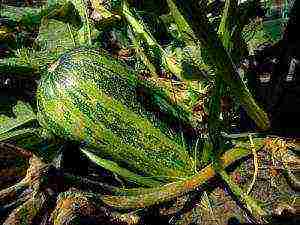
Why is zucchini useful
Zucchini contains many useful substances:
1 vitamin A and provitamin A - carotene, vitamins C, P and almost all B groups;
2 minerals - calcium, potassium, magnesium, iron, sodium, phosphorus, molybdenum, titanium, aluminum, lithium, zinc, as well as salts of potassium, phosphorus, calcium, magnesium;
3 of the acids is nicotinic.
Due to its composition, rich in vitamins and microelements, the vegetable, which gardeners love to grow so much for its unpretentiousness and fertility, is widely used for the treatment and prevention of various diseases.
• Try to keep this vegetable on your table frequently. If you use it regularly, you can get rid of excess fluid (acts as a diuretic), toxins, toxins. It is often recommended for those suffering from edema of various origins.
• Fiber, which is rich in zucchini, promotes better metabolism, removes food residues from the intestines, improving its motility. Therefore, zucchini is advised for constipation, for other problems with the intestines.
• Glycogen improves blood formation, prevents atherosclerosis. This is a great help for those who have problems with the cardiovascular system! In addition, the iron contained in this vegetable enriches the blood with oxygen, which is important for patients with anemia.
• Due to the sparing effect on the mucous membranes of the stomach and intestines, zucchini can be used as a restorative agent (along with other products) in case of poisoning of various etymologies.
• It is believed that zucchini contributes to the rejuvenation of the body. It is rich in antioxidants and vitamins present in high amounts. Moreover, it can not only be taken orally, but also in the form of a gruel, applied for 20 minutes on the skin of the face.
• Zucchini is also advised for those who suffer from joint diseases, allergies, hepatitis, hypertension, gout. In addition, it is indispensable for poor condition of hair, skin and teeth. Girls who are passionate about their appearance consume this product during a diet. Zucchini (due to its medicinal properties) is included in many diets.
Tip: so that the beneficial properties are not lost when processing this vegetable, do not simmer (fry) it for too long. Young zucchini is ready to eat in 15-20 minutes.
Zucchini on your table
• We can treat our family with fresh zucchini for quite a long time, from spring to late autumn. Eager hostesses prepare salads, stews, caviar from zucchini, make winter preparations. Zucchini is stewed, boiled, fried, steamed, pancakes and casseroles are made from it, even jam, in general, is used to the maximum. The young vegetable is used in cooking with a crust that is thin, crispy and very healthy! In mature zucchini, the skin becomes thicker and coarser, it is cut off.
• Zucchini gives a lot of juice when cooked. Add just a little water.
• If you bake zucchini in the oven, replace your usual mayonnaise with sour cream or béchamel sauce. Zucchini will become softer, and sour cream is healthier than store-bought mayonnaise.
How to cook caviar the traditional way
All you need for this extremely simple and delicious dish are courgettes, vegetables, tomato paste, oil for frying in a pan, and spices. Grind all vegetables (carrots, onions, garlic if desired) in a meat grinder or blender. Fry the mixture in vegetable oil. Put the fried caviar mass into a blender again, mix everything again. Add salt, spices are added to taste and desire. It can be parsley, dill, parsnips.
If you want the caviar to resemble store caviar in consistency, add a little flour.
Zucchini fritters - both tasty and healthy
Perhaps, after caviar, pancakes made from vegetables are in second place in popularity among food lovers. They are loved by many housewives, as they are easy to prepare, do not require large financial expenditures, have an appetizing appearance and are always eaten at home! The mass for zucchini fritters is prepared in about the same way as for caviar. Zucchini, onions, carrots are finely and finely chopped (you can until the state of gruel - using a meat grinder, you can also on a medium grater), add flour, make pancakes and fry in oil, best of all in vegetable oil. Served with sour cream, both hot and cold.
How to grow zucchini yourself
Zucchini is an annual plant and must be planted again every spring.
Belongs to the pumpkin family. The fruits have an oblong shape, the fruit color is white, green, dark green. Ripe squash is usually yellow in color. Differs in fertility and early ripening. The average weight of a mature vegetable marrow is 0.8-0.9 kg. From one bush, you can get up to 5 kg of fruit.
Zucchini is grown either from seeds or seedlings are made. In any case, great importance is attached to the choice of the variety and the selection of planting material. Tips:
1. When choosing a variety, be guided by the region in which you live. If your summer is short, choose frost-resistant varieties of domestic origin. If your hobby site is located in the favorable southern zone of the country, try foreign varieties that have a long growing season.Some of the common varieties are Hybrid Nemchinovsky, Zucchini. Zucchini, by the way, has become very popular due to its fertility, early maturity and stamina.
2. The selection of seeds is carried out according to the principle of germination. Take a few seeds and try to sprout them. If they did not ascend or ascended rarely, it is better to discard these seeds and acquire others.
How to germinate seeds
Prepare the following solution: for one liter of water - a teaspoon of nitroammophoska or nitro-phosphate. As an option: potassium permanganate diluted in water to a maroon color, ROST-1 fertilizer, wood ash.
The seeds are soaked in a solution prepared in advance for several days. Before planting, they are rinsed with clean water and covered with a damp cloth for another couple of days (you can use gauze). They are placed in a warm, dry place and daily sprayed with a spray bottle with water.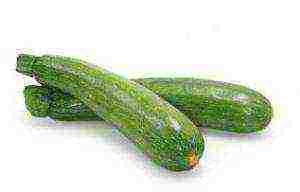
How to grow seedlings
• For seedlings, seeds do not need to be germinated, otherwise they will be yellow, frail. The seeds are planted in prepared cups (cut off tetrapaks from milk, yogurt; it is better not to use plastic containers, otherwise the excess liquid will linger and the sprouts will rot).
• Seeds are planted in the prepared soil (you can buy bio-soil in the store), fertilized with organic matter and mineral additives. Sowing depth - 3-5 cm.
• Watering is recommended infrequently: once every 5-6 days, but abundantly: half a glass of warm water per pot or glass.
• During growth, you can feed once or twice.
How to plant correctly
The area allotted for planting this vegetable is dug up in the fall, while fertilizing it - humus, peat, compost. In the spring, they dig up again, bringing in manure or compost for digging. Destroy weeds.
In the favorable conditions for which the south of Russia is famous, zucchini can be planted in open ground. But in the conditions of the Non-Black Earth Zone, this method of planting will not give high yields, the risk of frost and cold rainy weather is too great. Therefore, zucchini is planted in closed ground, and better - seedlings.
When the weather is warm and the threat of frost has passed, zucchini can be safely planted. Just in case, you need to stock up on covering material (ordinary film or special - agrotex, etc.), because the zucchini will not survive the night frosts. Seedling gives you the advantage: you pick the zucchini earlier than the ones that were planted with seeds.
Zucchini have large leaves and lashes, and therefore take up a lot of space on the site. For them, you need to make large beds. If there are several beds, the distance between them should be from 80 cm. The holes are rounded. Several plants are placed in one hole, 5 cm apart. Pre-pour the hole with cold water.
A few days after the emergence of shoots, one of the shoots can be transplanted to another bed or removed.
It is better to choose a place for beds with zucchini sunny, warm, open.
How to care for zucchini
• Beds with future zucchini must be covered with foil or agromaterial. And only when the night temperature reaches 12-14 ° C, the film can be removed.
• Regular watering will ensure a good harvest. Try to pour at the root, the leaves should not be wet. Before the plant begins to bloom, water about once a week at 8-12 liters per square meter. When the first fruits appear - every 2-3 days, increasing the volume of water. Young ovaries can rot from cold water. Drizzle with warm water.
• If the roots are slightly exposed during watering, cover them with soil or earth mixed with humus.
• Zucchini does not loosen or huddle. Otherwise, the roots may be damaged.
• Zucchini - cross-pollinated. There are two ways gardeners use to pollinate zucchini flowers to set fruit. one). Manually, applying the pollen of the male flower to the female ones. 2). With the help of bees, to attract which the flowering bushes of zucchini are sprayed with a solution - one teaspoon of honey in a glass of water (they do this in the morning).
• Remove overgrown leaves in time and harvest ripe fruits. They cover young ovaries from the sun, which negatively affects their growth.
• Zucchini is fed several times during the season.
1) Before flowering. Prepare such a solution: for a bucket of 10 liters - half a liter of mullein and a tablespoon of nitrophoska.
2) During flowering: in a 10-liter bucket - a glass of wood ash.
3) During fruiting: for 10 liters of water - one tablespoon of superphosphate, potassium sulfate and urea.
In one and a half to two months, with proper care, you will get a good harvest of zucchini!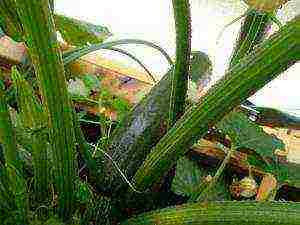
How to preserve the harvest
Of course, you won't save them until next summer. But until December - January - quite. For this, only ripe fruits with a thick peel ripened directly in the garden are suitable. They must be intact, without any damage.
It is better to remove from the lash with the stalk, in dry, sunny weather. Do not remove them immediately, let them soak in the sun (the skin will harden even more, which will prevent moisture loss and preserve the harvest).
You can store it in the cellar, closet, utility room, under the bed. The main thing is that the place is cool, dark and dry.
May your work pay off in full! Good harvests and hearty winters!
Published by 18.11.2016 |
Recently, growing various fruits and vegetables at home has become commonplace. Zucchini is one of the most popular crops.
Variety selection
Before you start growing zucchini at home, you need to decide on the variety. If you plan to place vegetables on the balcony, then pay attention to the following types:
- aeronaut. A feature of the variety is that it is completely unpretentious;
- zebra. Ideal for growing at home, since the species has good resistance to the influence of various factors;
- tsukesha. The variety is distinguished by a large amount of yield.
All of the above options are among the most popular. But in addition to these, there are several more species that lend themselves well to growing at home.
Particular attention should be paid to a variety called Belogor. This type is hybrid, and is well served for growing on the balcony.
During early autumn, you can choose a variety called roller. The fruits withstand cold weather well and are small in size.
Another good option would be the anchor variety. A feature of this species is that the fruits can be stored for a long time after harvest.
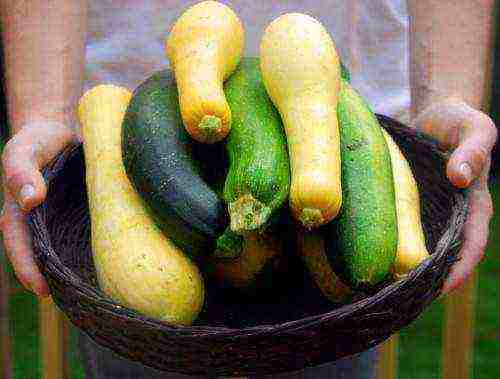
Growing technology
After choosing a variety, you need to start arranging a place that will serve as a mini-vegetable garden. A balcony is best suited for this process.
Next, you need to pay attention to the following points:
- selection of a container for planting. The most suitable option would be wooden boxes;
- creating holes. They need to be done at the bottom of the container (necessary for water drainage);
- installation of lamps. Additional lighting will be needed if you decide to start growing in the fall.
As for the soil, you need to purchase it in a special flower shop. For planting, you can not use the land from the garden or peat.
Next, you need to tackle the main process. At the beginning, the seeds are wrapped in cheesecloth, after which they wait 2 days for the roots to appear.
Then, you need to water the ground with warm water. The temperature should be between 23-25 degrees.
Next, proceed to planting. The sprouts should be positioned so that the depth is approximately 3 cm.
After 7 days, treat the seedlings with a special mixture that activates the growth of zucchini.
This video will help you grow zucchini on the balcony:
Kamila_Feodosya
0 0

To grow zucchini on the balcony, a pot requires a large volume
If the loggia is glazed and completely closed from the ingress of exhaust gases and heavy metals from the street, then growing zucchini on the balcony in an apartment for your own table is, in principle, possible.But I will not change my opinion that it is simply dangerous to cultivate vegetables and berries on the balcony for food.
But as an original decor, zucchini is an interesting and simple option for landscaping. It is quite simple to care for these plants, and the requirements for the composition of the soil are minimal.
Signor zucchini on the balcony - growing
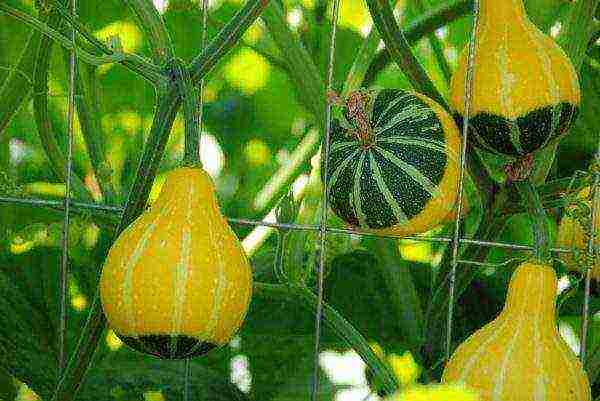
Vietnamese zucchini on the balcony
What varieties of zucchini will look beautiful on a balcony or loggia? It is better to choose compact bushes with beautiful foliage and bright original fruits. In ordinary zucchini, the leaves are huge, resembling burdock and are simply not suitable for a small balcony space.
Interesting and original varieties of the latest selection that are suitable for growing on the balcony:
- Festivalny is an original variety with small fruits resembling a watermelon, striped green-yellow with white stripes. The bush is compact and will look very nice in a low pot.

In the photo, the legendary, which can be colored, will resemble a flamingo
- Vietnamese zucchini or Indian cucumber - but in fact a legendaria (bottle gourd) - looks very peculiar, you must agree.
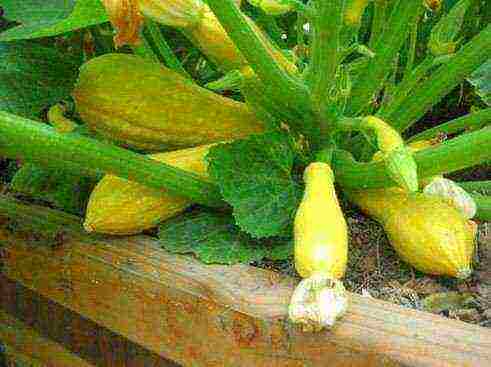
Kruknek - original design
- Kruknek is a new zucchini variety with different fruit colors.
Also interesting are the varieties Tapir, Striped Ball, Burzhuin, Zephyr.
An interesting fact - zucchini belongs to the type of pumpkin, but they have a thick peel like squash.
Detailed recommendations for growing zucchini
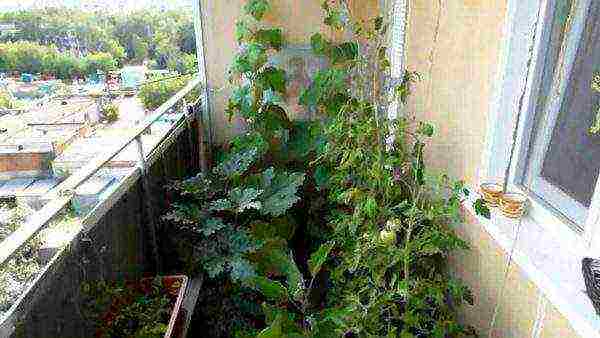
It will look something like the one in the photo.
So, growing zucchini on the balcony step by step:
- Seeds will sprout friendly shoots if they are soaked in warm water for three days before planting, covered with cotton wool or three layers of gauze. We make sure that the cotton is wet all the time.
- Soil mixture for planting - peat, sawdust and humus in the ratio of 5 parts of peat, 4 parts of humus and one part of sawdust... But ordinary flower primer, which is sold in a store, is also suitable.
- You can germinate seedlings in advance by planting the seeds in cups on the windowsill. But if we are not waiting for the harvest, then we plant it immediately in boxes on the balcony or loggia.
- Since the bushes are fluffy, the distance between the plants must be kept from 40 to 50 centimeters.
- We plant the seeds in the ground after frosts are no longer expected, then the seeds will germinate in a week.
- Further, plant care is reduced to regular watering and loosening the soil once a week..
Zucchini is an unpretentious plant and grows in any, even Spartan conditions. But growing these vegetables on the balcony is, to put it mildly, strange. And if you eat them, then they are also dangerous.
Vegetables on the balcony of a big city - a toxic concentrate of carcinogens
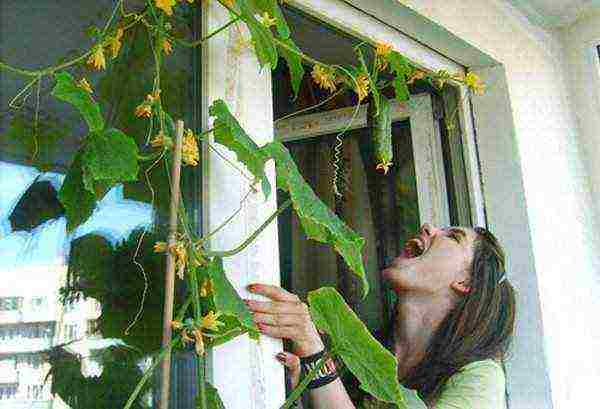
Urban vegetables are an excellent source of lead and heavy metals
I'll try to argue my point of view:
- Exhaust gases from road transport, especially diesel, which is becoming more and more from year to year, contain a large percentage of heavy metals that are fatal to humans.
- Pay attention to your windowsill in the morning and late afternoon. In apartments located near busy highways, a layer of dust forms on the windowsill during the day, even with tightly closed windows. These are settled particles of exhaust gases and city smog.
- The most dangerous is lead, which gets from the soil into the stems of plants almost instantly.... Practical research shows that one kilogram of grass growing by the road contains 100 mg of lead, and forest grasses contain this metal in an amount of 10 mg per kilogram. Feel the difference, as they say.
- Even goats and cows that graze along the route produce milk with a high content of lead and heavy metals. And how many of them will there be in a zucchini that has grown on the balcony, the price of which in the summer in any store is a penny?
- Car brake pads emit 400 thousand tons of metal dust per year. Where does it settle?

Growing vegetables in the city center is a dubious business!
- Tires, rubbing into the smallest particles on the asphalt, are also a source of rubber in vegetables and fruits grown on the balcony.
Now ask yourself a question - do you want to eat zucchini with rubber, lead and heavy metals? If you are not a Terminator, then it is unlikely.
The Environmental Safety Instruction mandatorily regulates the planting of protective forest belts of trees and shrubs along highways and busy highways that trap a large percentage of heavy metals and other harmful substances.
Laboratory research of ecology of the Moscow region
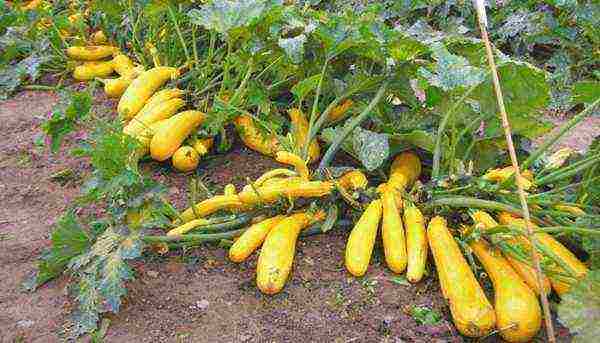
Should I mock myself and the plants?
The laboratory at Moscow State University decided to analyze the soils in the gardens located near the Moscow Ring Road. Research data are disappointing:
- At a distance of 10 meters from the road, an increased concentration of lead was observed in vegetables, exceeding the permissible norm by two times. At a distance of 100 meters from the routes, the concentration of metals decreased by half.
- It is comforting that at a distance of 100 meters from the track, the content of metals in vegetables and fruits was within normal limits.
- In apples grown near highways, the concentration of lead exceeded the permissible standards by three times and, even at a distance of 600 meters from the highway, decreased insignificantly.
- In acidic soil, heavy metals become more mobile and their concentration in all products grown on such soil increases by a factor of two, and sometimes even three times.
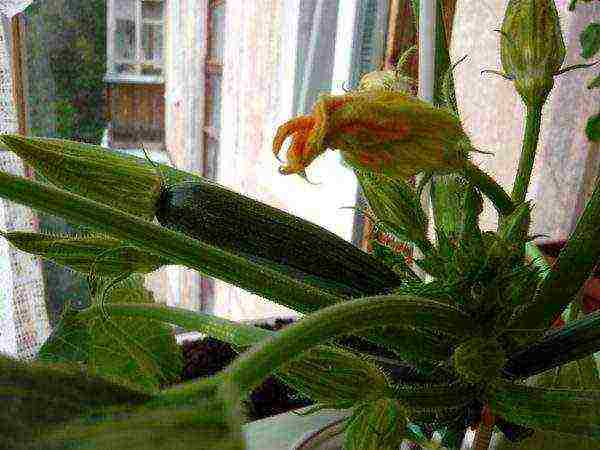
This culture can be grown as a pretty decor
Summary
Many summer residents living next to a busy highway try to reduce the danger of vegetables by liming the soil. However, I do not think that it is worthwhile to grow a time bomb in the form of a zucchini with heavy metals for yourself on the balcony with your own hands.
And yet, for those who want to try themselves as an agronomist, I recommend looking at the video in this article, the plot will tell you in detail about the cultivation of zucchini on the balcony. And I invite all interested readers to discuss this topic in the comments!
September 16, 2016
If you want to express gratitude, add clarification or objection, ask the author something - add a comment or say thank you!
